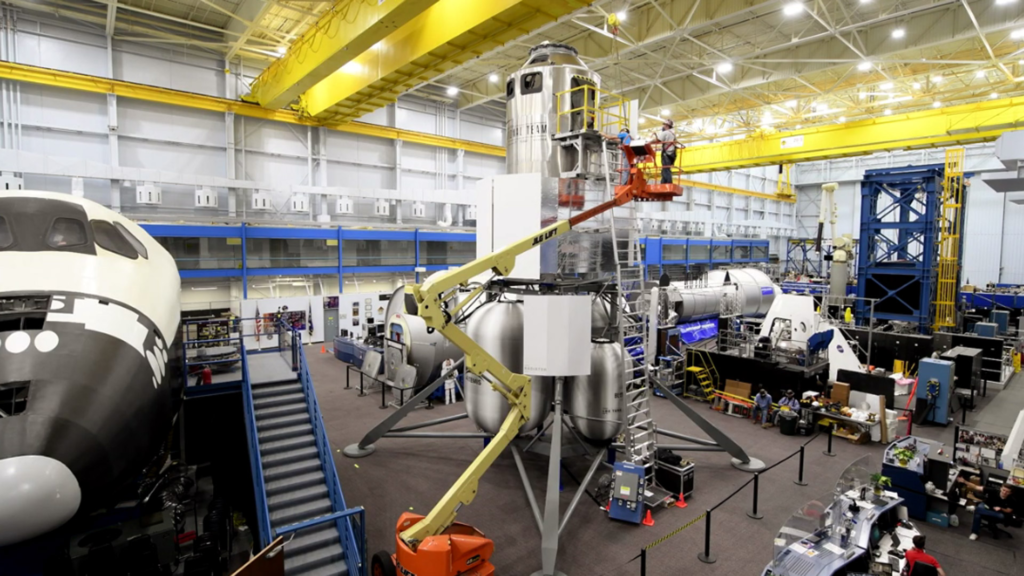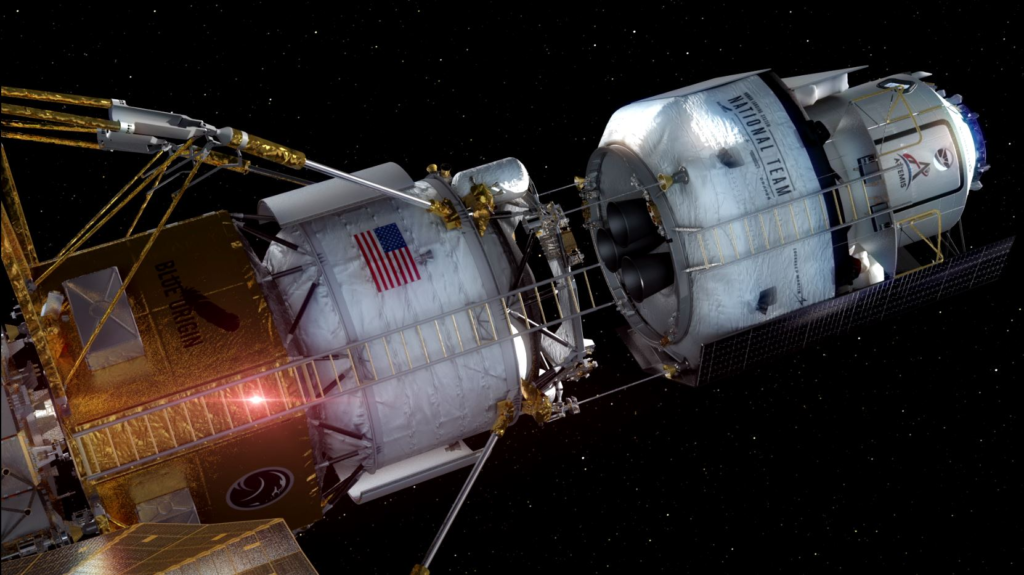
What Progress Has Been Made On Blue Origin’s Moon Plans?
For years now Blue Origin and the National Team have been working to develop, manufacture, test, and present a human landing system for the Moon. As NASA continues to make progress on Artemis and returning humans to the Moon, the need for dedicated systems that can safely land on and ascend from the surface becomes higher.
While at first, the National Team had no luck when SpaceX’s lunar Starship was chosen, they are now trying again. This comes in addition to more work on various components including the BE-7 engine, and much more. All of which will need to be very convincing in order for NASA to give out a massive contract to the team.
With this new proposal comes a few changes to the team and parties involved. For example, Northrop Gruman is no longer apart of the primary National Team, while Astrobotic and Boeing were added. Not to mention the fact that SpaceX is prohibited from competing for SLD as that company had won a $2.9 billion HLS contract in April 2021. Here I will go more in-depth into some of the changes to the National Team, what progress has been made, what to expect in the future, and more.
New National Team

Originally, NASA offered a competition for a significant human landing system contract between SpaceX, the National Team, and Dynetics. After a thorough assessment, the agency picked SpaceX and awarded the company $2.9 billion. Even more recently SpaceX was awarded a contract modification with a value of about $1.15 billion.
However, in March of this year, the agency came out with even more news. As NASA continues to work toward returning humans to the lunar surface under Artemis, the agency announced plans to create additional opportunities for commercial companies to develop an astronaut Moon lander. Under this new approach, NASA asked American companies to propose lander concepts capable of ferrying astronauts between lunar orbit and the lunar surface for missions beyond Artemis III, which will land the first astronauts on the Moon in more than 50 years.
This is where the new proposal from Blue Origin and the National Team came in just weeks ago. Specifically on December 6th Blue Origin tweeted saying, “The National Team has submitted its proposal for NASA’s SLD program to help the US establish a sustained lunar presence. The National Team partners are @BlueOrigin, @LockheedMartin, @DraperLab, @Boeing, @Astrobotic, and @Honeybee_Ltd.” “As the only company to successfully build a crewed lunar lander, Northrop Grumman will be an excellent partner as we support NASA’s inspiring efforts to return humans to the lunar surface,” said Steve Cook, president of Dynetics, in a statement, referring to the development of the Apollo-era Lunar Module by Grumman Aerospace. “We believe our partnership with Northrop Grumman makes us more than ready for the challenge.”
One of the main focuses that Blue Origin makes clear is the widespread teamwork on this project. For example, they highlighted the national aspect of its team using suppliers in 48 of 50 states, excluding Nebraska and North Dakota. As far as the design of this lander, it will most definitely share a lot of similarities with the previous option, however, the specific details will not be available until NASA has made its decsion on what lander wins the contract.
Back in December of 2020, the National Team submitted its Option A proposal to land on the Moon in partnership with NASA. At the time, Blue Origin led the Human Landing System (HLS) National Team, which included Lockheed Martin, Northrop Grumman, and Draper. They highlighted that together, these partners guided Apollo, established routine orbit cargo transfer, developed today’s only crewed lunar spaceship, and pioneered planetary precision landing with liquid hydrogen/liquid oxygen vehicles. The proposed solution was intended to use flight heritage and modularity to manage risk, move fast, and attain sustainable operations on the Moon. Unfortunately, the lander was far too expensive and NASA was not confident in its future compared to other options, a decision the National Team is hoping to change in the near future.
Proposal & Development

Now that we know more about the new proposal and some of the changes within the National Team, we can take a closer look at some of the core components and any progress being made. Blue Origin has been developing engines for a very long time now. While the BE-4 has not been perfect, the company is now ramping up production and the engine’s first test flight is only months away. In the case of a lunar lander, BE-7 is the engine responsible. Recently, in a panel during the American Astronautical Society’s Wernher von Braun Memorial Symposium in October, Ben Cichy, the senior director of lunar program engineering at Blue Origin, said his company has also used Appendix N to advance key technologies in several areas, such as cryogenic fluid management for the hydrogen fuel used on its BE-7 engine.
Ben Cichy, senior director of lunar program engineering at Blue Origin, said his company has also used Appendix N to advance key technologies in several areas, such as cryogenic fluid management for the hydrogen fuel used on its BE-7 engine. BE-7 is an additively manufactured, high-performance, dual-expander cycle engine, generating 40 kN (10,000 lbf) thrust. Blue Origin is maturing the design, manufacturing hardware and have begun hotfiring the engine. The high specific impulse, deep throttling, and restart capabilities of the BE-7 make the engine ideal for large lunar payload transport while enabling Blue Moon’s oxygen and hydrogen fuel cell power system. Blue Origin put a lot of work into simplifying and cleaning up the design and plumbing of the BE-7 engine. Positioned at the top is the thrust chamber assembly, right under is the hydrogen pump and oxygen pump. Finally, you have the large nozzle assembly at the bottom of the engine. Technology and core components like this engine are important aspects of NASA’s upcoming decision for future landers.
Originally, in early 2020, the Blue Origin National Team was selected by NASA to begin to develop the Artemis Human Landing System. Here Blue Origin, as prime contractor, lead program management, systems engineering, safety and mission assurance, and mission engineering and operations; and developed the Descent Element. Lockheed Martin developed the reusable Ascent Element vehicle and leads crewed flight operations and training. Northrop Grumman developed the Transfer Element vehicle that delivers the landing system into low lunar orbit for final descent. And Draper lead descent guidance and provides flight avionics. Whether or not the changes to this team will be helpful is yet to be determined.
“Under Artemis, NASA will carry out a series of groundbreaking missions on and around the Moon to prepare for the next giant leap for humanity: a crewed mission to Mars,” said NASA Administrator Bill Nelson. “Competition is critical to our success on the lunar surface and beyond, ensuring we have the capability to carry out a cadence of missions over the next decade. Thank you to the Biden Administration and Congress for their support of this new astronaut lander opportunity, which will ultimately strengthen and increase flexibility for Artemis.”
NASA’s plans call for long-term lunar exploration and include landing humans on the Moon as part of future Artemis missions. The agency is pursuing two parallel paths for continuing lunar lander development and demonstration, one that calls for additional work under an existing contract with SpaceX, and another open to all other U.S. companies to provide a new landing demonstration mission from lunar orbit to the surface of the Moon.
As we know, in April 2021, NASA selected SpaceX as its partner to land the next American astronauts on the lunar surface. That demonstration mission is targeted for no earlier than April 2025. Exercising an option under the original award, NASA now is asking SpaceX to transform the company’s proposed human landing system into a spacecraft that meets the agency’s requirements for recurring services for a second demonstration mission. Pursuing more development work under the original contract maximizes NASA’s investment and partnership with SpaceX.
To bring a second entrant to market for the development of a lunar lander in parallel with SpaceX, NASA will issue a draft solicitation in the coming weeks. This upcoming activity will lay out requirements for a future development and demonstration lunar landing capability to take astronauts between orbit and the surface of the Moon. This effort is meant to maximize NASA’s support for competition and provides redundancy in services to help ensure NASA’s ability to transport astronauts to the lunar surface. The upcoming second contract award, known as the Sustaining Lunar Development contract, combined with the second option under SpaceX’s original landing award, is expected to pave the way to future recurring lunar transportation services for astronauts on the Moon.
Conclusion
Blue Origin and the National Team recently submitted a second proposal to NASA for a significant lunar contract. While the first attempt was not successful, they now have a slightly new team, less competition, and more development than before. We will have to wait and see how it progresses and the impact it has on the space industry.
